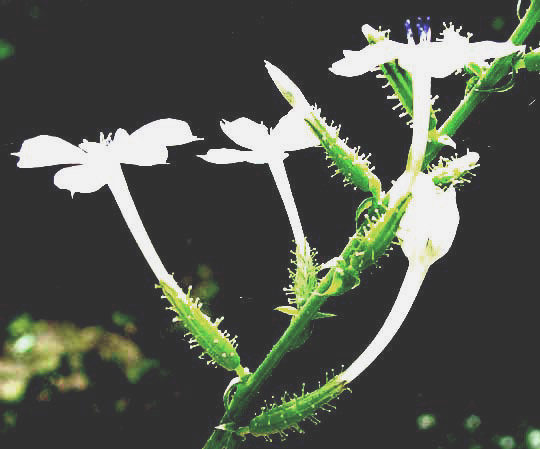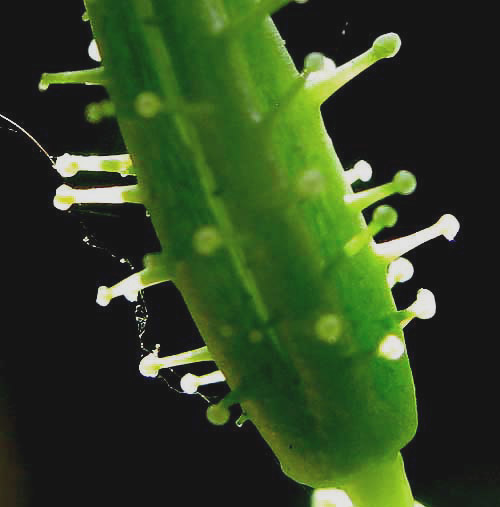Excerpts from Jim Conrad's
Naturalist Newsletter

from the November 22, 2009 Newsletter issued from Hacienda Chichen Resort beside Chichén Itzá Ruins, central Yucatán, MÉXICO; limestone bedrock, elevation ~39m (~128ft), ~N20.676°, ~W88.569°
LEADWORT
Above you see a "weed" commonly encountered here at woods edges, its flowers dazzlingly white against lush green herbage behind it. A close-up of a flower cluster revealing important field marks for identification is shown below:

The corollas almost look like those of phlox flowers but this plant is in an entirely different family. The long, slender tube topped by flaring, horizontal lobes (such corollas are said to be "salverform") is a basic corolla shape for plants pollinated by insects with long proboscises such as butterflies, and occurs in several plant families. But, note the large, stalked glands covering each flower's calyx. A close-up of the sticky stalked glands, which I suspect keep wandering, grazing insects from getting to the flowers, is shown below:

When you see phlox-like corollas arising from very glandular calyxes you should think "genus Plumbago," the Leadwort genus. Several Leadwort species are known; the one in the picture is PLUMBAGO SCANDENS. Plumbagos are members of the Leadwort or Plumbago Family, the Plumbaginaceae. Possibly the most commonly encountered garden species is a blue-flowered one. The Leadwort Family, embracing about ten genera and 300 species of herbs and shrubs throughout most of the world, specializes in saline or limestone environments, which sounds right since the Yucatan is basically one big slab of limestone.
It's not clear what the Leadwort Family has to do with lead but I've read one theory that Leadworts were once used medicinally against lead poisoning. I don't know if that's right, but it's certainly true that many cultures regard Leadworts as important medicinal plants.
Maxamino Martínez's Las Plantas Medicinales de México devotes nearly four pages to Leadworts and mentions cures ranging from ending "any pain at all" to stopping gangrene. He even quotes a 1615 publication by the "modest Dominican friar" Francisco Ximénez that Leadwort juice mixed with "Temecatl" -- possibly the "Tropical Grape" we looked at last week, known in Nahua as Temecate -- as useful in catching women. A Dr. Leopoldo Flores is quoted as saying that malignant tumors can be made to disappear by injecting Leadwort extract directly into the growths.
Several authors report that if you place a bruised Leadwort leaf on the skin for ten minutes it'll stain the skin gray-brown for several days. I tried that and may have developed a very slight reddish rash but nothing worth photographing.
On the Internet several technical papers report on effects of Leadwort extract on the human body, so Western science definitely is paying attention to Leadworts. Charles Kane's Herbal Medicine of the American Southwest -- accessible as a Google Book by Goggling the title -- proposes three external uses for Leadwort: 1) to speed up healing of wounds; 2) to counter edema's fluid build-up, and; 3) to bring abscesses to a head or draw out splinters. Kane suggests applying Leadwort to the skin as a poultice or fomentation, or in a salve or oil.